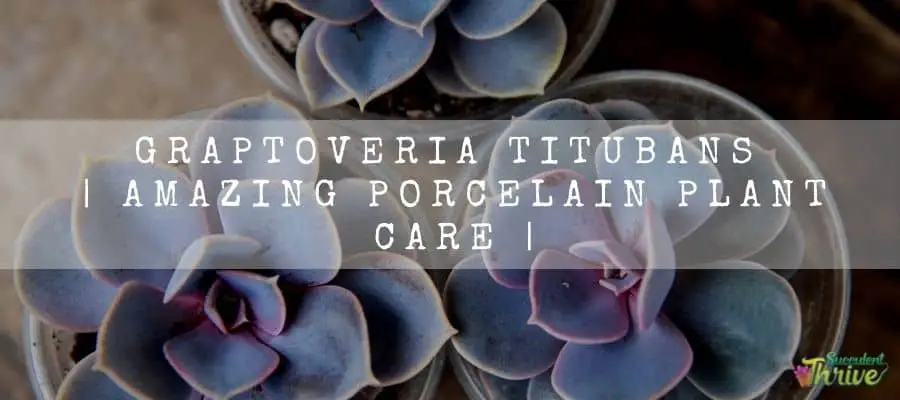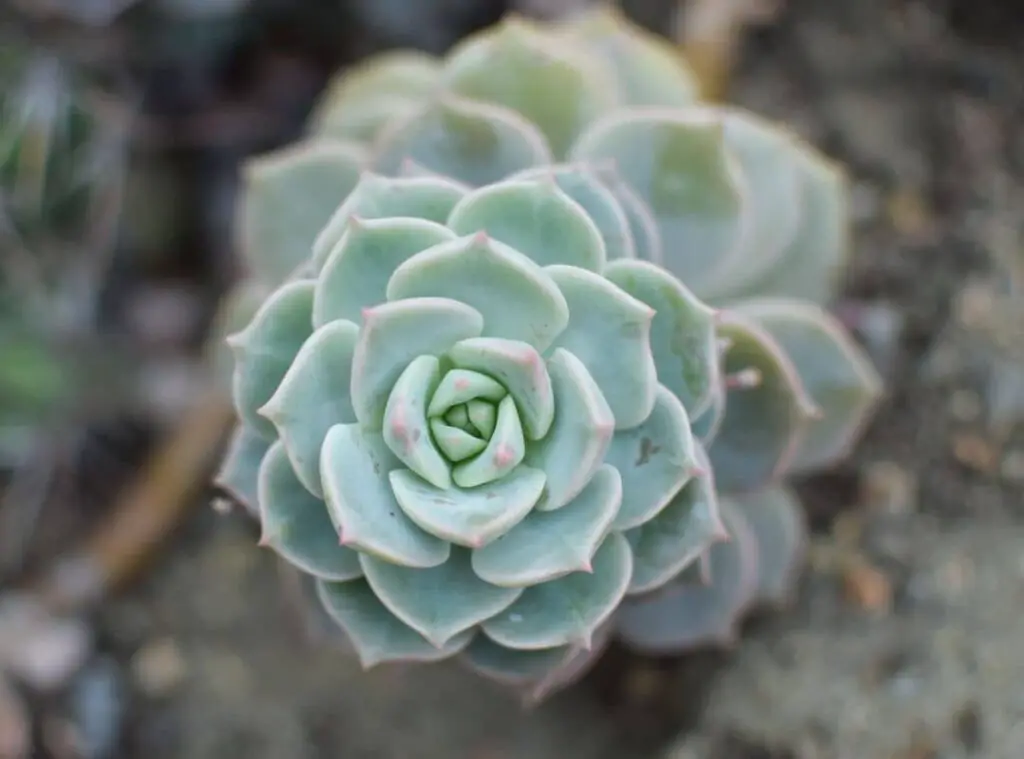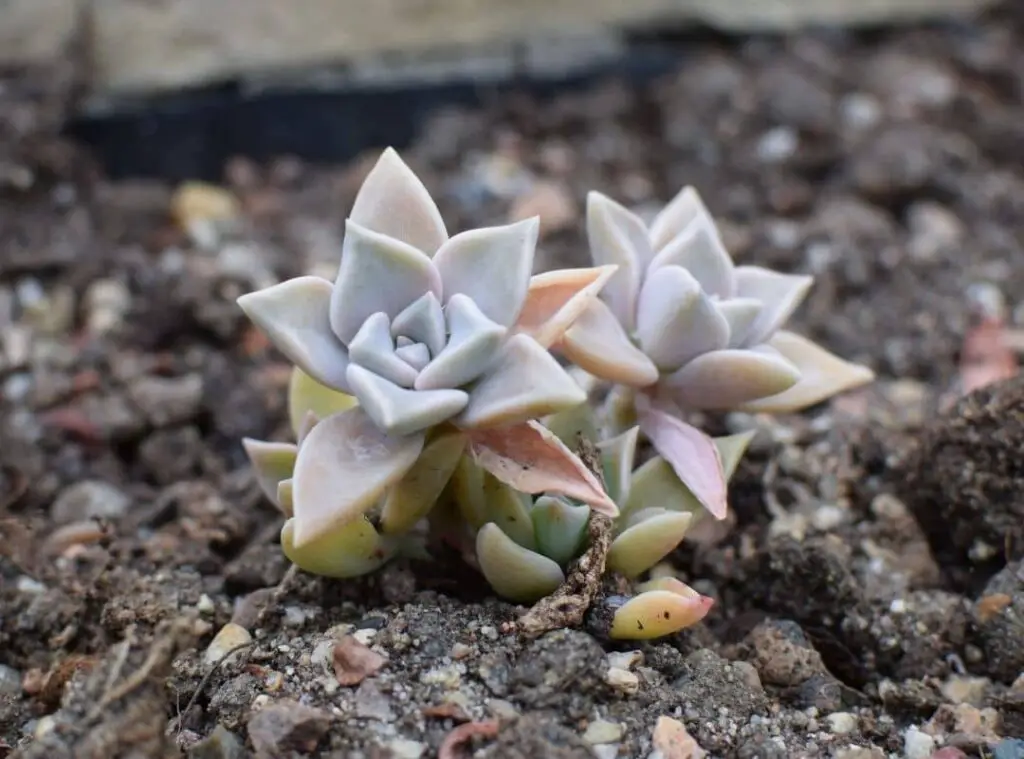Graptoveria titubans is a cross plant made using two succulents called Graptopetalum paraguayense and Echeveria derenbergii. It is in fact an intergeneric cross between these two plants.
The mat green colored leaves are the highlight of these plants. They are rosette forming plants. When they are properly stressed you will see how those leaves change their colors into pink.
On top of these characteristics, these are flowering plants too. Porcelain Plant is the common name of these plants.

Succulents usually thrive well with minimum supervision from you and Graptoveria titubans are no different to them.
As such anybody can start growing these plants. This article is a comprehensive guide on how to grow the Graptoveria titubans well and the right growing practices you need to do when looking after them.
Besides, we are going to cover the common bugs and illnesses, and you may come across them when growing them. If you wish to grow these plants, you will find this article very useful.
How do I identify Graptoveria titubans?
They will reach a maximum height of 20 cm ( 8 inches ) when they grow to their best.
As aforesaid, these are quite famous for their matt green colored leaves which form in rosette types. colder temperatures will make these plants go through stress and consequently those leaves will turn pink to apricot.
Those leaves will usually form along the long sprawling stems. The rosettes width would be slightly under 3 inches. However, when they mature, they will rise to 8 inches.
The Graptoveria titubans leaves would be thick and fleshy. Furthermore, they would be spoon shaped.
In addition to aforesaid features, Graptoveria titubans produce flowers. Graptoveria titubans produce offsets freely.
They will be yellow in color, and you could identify the Graptoveria titubans plants from flowering during spring.
Size of the plant
Graptoveria titubans would rise to 20 cm ( 8 inches ) in height.
Growth rate
Graptoveria titubans are renowned as a slow growing set of plants.
One look care guide
| Botanical Name | Graptoveria titubans |
| Common Name | Porcelain Plant |
| Plant Type | Succulent |
| Mature Size | 20 cm ( 8 inches ) in height. |
| Sun Exposure | Full sunlight to partial shade |
| Soil Type | Well-draining |
| Soil pH | ph. 5.0 – 7.0 Acid – Neutral |
| Bloom Time | Spring |
| Flower Color | Yellow |
| Hardiness Zones | USDA hardiness zones 10a-11b -1.1°C (20 F) |
| Native Area | N/A |
| Toxicity | Non-Toxic |
| Average price | 9 USD |

How do you take care of Graptoveria titubans?
Light Requirement
Graptoveria titubans are very demanding when it comes to sunlight as they require bright sunlight to perform well.
It is essential to provide 6-7 hours of morning sunlight for their optimal growth. In case if you grow them whilst providing inadequate sunlight, it will make them etiolated and lean towards the best possible light source they can reach.
A bright sunny spot like a windowsill would suit these plants the best when you grow them indoors. The growth of the plants would be benefitted from that.
However, when you grow them indoors, make sure that you rotate the plants on a weekly basis so that you can assure that the entire plant receives the sunlight evenly.
Besides, when you have grown the Graptoveria titubans indoors for some time and wish to bring them outdoors during summer, keep in mind that you should refrain from exposing them to intense full sunlight at once.
If you do so, it will scorch the plants. The worst thing about sunburns is that you cannot get rid of those spots no matter what you do to get rid of them.
When you expose them to full sunlight, you can ideally start it off by exposing them for about one hours’ time first. Next day you can increase it to two hours to three hours.
Literally you need to gradually expose them to full sunlight so that they have enough time to get used to it.
That will allow the plants to adapt to the new conditions. Unless chances are that they may go through traumas.
Temperature and humidity
Graptoveria titubans optimal temperature conditions would be warmer temperatures.
Ideal temperature which would suit these plants would be 65 degrees Fahrenheit – 75 degrees Fahrenheit. ( 18 degrees Celsius – 24 degrees Celsius).
Extreme Colder temperatures would not go well with the Graptoveria titubans plants.
Having said that, they can withstand some frost too. In fact, the minimum temperature they could tolerate is 1 to -1 degrees Celsius.( 20 degrees Fahrenheit ).
In terms of humidity, they will love to have average humidity levels. In fact, the natural room humidity levels would be sufficient for them to grow firmly.
If you expose them for high humidity levels, it will create root rot in the plants.
As such they would not be the types of plants which thrive in humid places such as the bathrooms. Furthermore, if you can place a fan, it will improve the air circulation.
Is it cold hardy?
USDA Hardiness Zone
USDA hardiness zones 10a-11b -1.1°C (20 F) would be perfect conditions for the Graptoveria titubans vigorous growth.
Watering Requirement
Moderate watering would work well with the Graptoveria titubans plants. Graptoveria titubans have typical succulent water requirements.
Graptoveria titubans leaves also conserve water and they use it when they are in drought conditions. However, you need to water the Graptoveria titubans quite often during summer.
To be precise, you need to water them once a week. Moreover, you need to water them when their soil is dry too.
Graptoveria titubans do not prefer to stay in soggy and damp soil at any cost. On the other hand, if the plants are lacking sufficient water, you will spot their leaves are wrinkled.
Graptoveria titubans can thrive with minimum water during winter. In fact, you can water them once every month during winter.
When you limit watering them during winter, it will reduce the potential of having any root rot. Furthermore, you need to water the plant base when watering.
Do not spill water on the plants rosettes as it will be unhealthy for them as it could lead to root rot. If you splash some water on them, you can wipe it off with some tissues.
Soil Requirement Type / pH
A fertile potting medium which has an excellent draining would be optimal for the healthy growth of the Graptoveria titubans plants.
A porous soil mix would go well with them. Consequently, it will minimise the potential of having any root rot. You can either grow them in a cactus well-draining soil mix or make one on your own.
Pot size Potting and Repotting
I suggest you go ahead with a plain, terracotta pot to grow the Graptoveria titubans plants. Besides, it needs to have a draining hole as well.
These features will help to get rid of the excess moisture and minimize the potential of having a root rot in the plants.
Besides, I encourage you to repot the plants when you freshly bring the plants from the nurseries.
To repot, you need to remove the plants from the pots, clean the older soil around the plants and then repot them in a new pot which you have filled with a fresh well-draining soil mix.
When you repot them once you bring them from the nurseries, you do not need to do it quite frequently since these are not the types of plants which grow faster.
Hence repotting them once every two years would be sufficient. Furthermore, when repotting , avoid using way too large pots to grow the Graptoveria titubans plants.
Instead choose a slightly larger pot. If you use larger pots, there will be a large amount of soil and it will conserve excess water in the pot which would ultimately result in root rot.

Where to Plant
When selecting a place to grow the Graptoveria titubans, what you need to mainly consider is whether the location you selected will fulfil the plant’s sunlight requirement.
If you wish to grow them in a garden, select a spot where they can receive both full sunlight and partial shade. Do not select a place where they will be exposed to harsh sunlight all day.
Additionally keep in mind that they want warmer temperature levels also for their survival.
If you are someone who lives in a colder area, I advise you to grow them as houseplants given that you fulfill their light requirement.
Besides, when you grow them as houseplants, ensure that you stick to aforesaid pot types and the soil mixes as well.
Flowers
Graptoveria titubans produce flowers in yellow. You could expect them to flower in spring.
Fertilizer and time of year
I encourage you to apply a fertilizer which is specifically made for succulents and or cactus as well.
However, it would be safer if you could dilute it and then apply so that there will be no probability of having feed burns in the plants. Frequency wise, you can limit feeding them once a month during summer.
Dormancy
Toxicity
Graptoveria titubans are not toxic plants for both pets and for humans.
Common bugs and illnesses
Root rot
Graptoveria titubans can thrive well even if you forget to water them once or twice simply because they have conserved water in their foliage.
However, over watering or if you keep their soil waterlogged for too long, will make the plants more prone towards root rots.
If you spot the leaves around the bottom of the plants are rotting, it literally means your Graptoveria titubans are experiencing root rot.
If you want to ascertain this, you can simply take the plant out of the pot and knock the older soil away around the roots.
If you spot any rotten and black roots, you can snip them off. Next, wither them for some time and plant them in a fresh pot. Finally, you can water them less frequently.
Mealybugs
Mealybugs could be troublesome for the Graptoveria titubans plants when they grow. They are small and wingless.
You could spot them in Graptoveria titubans plants commonly. They prefer to occupy the places where the leaves get in contact with the stems.
They produce a white cottony mass on the plant’s surface, and you can identify them from that feature. Mealybugs depend on the plant’s sap, and they pierce it whilst using their straws in the mouth.
To remedy them, you can use an insect spray, detergent, or even soapy water. Ensure that you keep continuing these steps until you get rid of them entirely.
Aphids
Aphids could be yet another annoying set of pests for the Graptoveria titubans. They can multiply at a very fast rate.
Aphids also depend on the Graptoveria titubans plants sap. You could spot the aphids in green white or in black. You can use a detergent or any other household horticultural bug spray to overcome the menace from the aphids.

How to propagate Graptoveria titubans
How to propagate the Graptoveria titubans by using the leaves
First you need to twist a leaf from the plant. Ensure the leaf you selected is a healthy one. So do not go ahead with wrinkled or dried out leaves for this process.
Furthermore, you need to get the whole leaf from the plant. Let them callous for a few days afterwards. After that, You can grow them in a soil mix.
You can spray some water once a week whilst exposing them for filtered sunlight. Refrain from moving the plants when they are in the process of establishing the roots.
You will see how they produce small rosette after a week’s time. When it is established, you can remove the leaf which you used for the propagation process.
Next you can pot them individually and continue with the regular care treatments.
How to propagate the Graptoveria titubans by using the cuttings
If you have etiolated plants, you can use their cuttings to propagate them.
You can make the cuttings by using a pair of sharp garden shears and cut them at least 1.5 inches below the rosette stem.
Next just like in the leaf propagation method, you need to allow the cuttings also to develop callous.Next plant them in a well-draining potting medium. After about one week’s time you can resume watering them.
How to propagate the Graptoveria titubans by using the Offsets
Graptoveria titubans plants produce offsets and when they are about quarter size of the parent plant, you can simply remove them and grow them in individual pots. Next keep providing regular care treatments for them.
Finally
Graptoveria titubans plants are such a glamorous set of plants which anybody would love to have. When they are stressed, you will see how their leaves’ margins turn pink.
The yellow-colored blooms will add more beauty for the Graptoveria titubans plants. Trust you found this article useful !
Read Next : Hildewintera Aureispina | Majestic And Beautiful Cactus | Kalanchoe Humilis | A Kalanchoe With Tiger Like Markings | Do Crassula Umbella Flower ? | Story Of The Cutest Flower |
